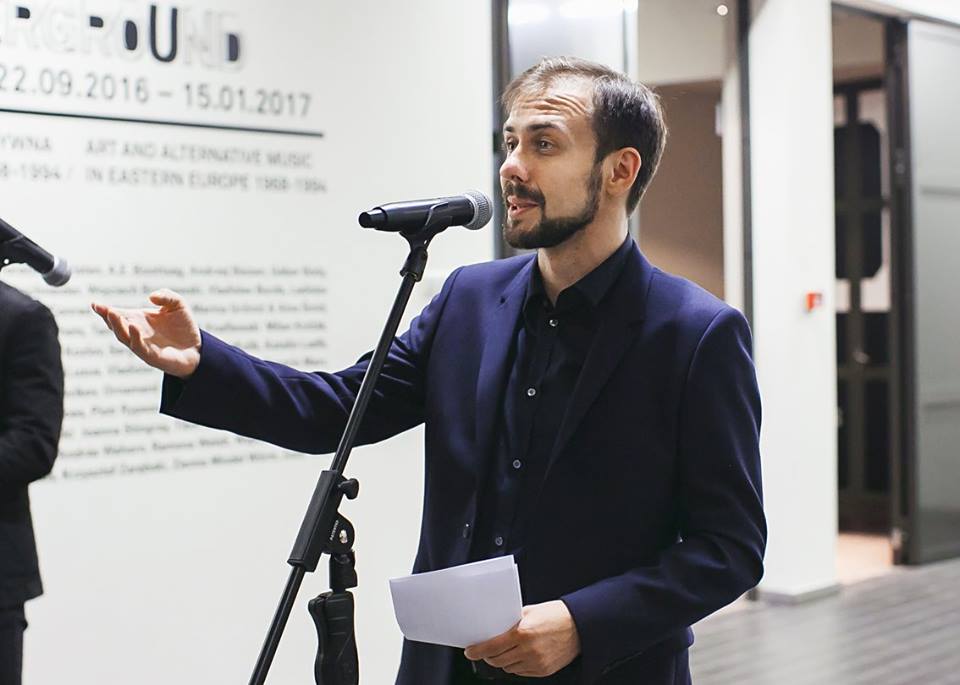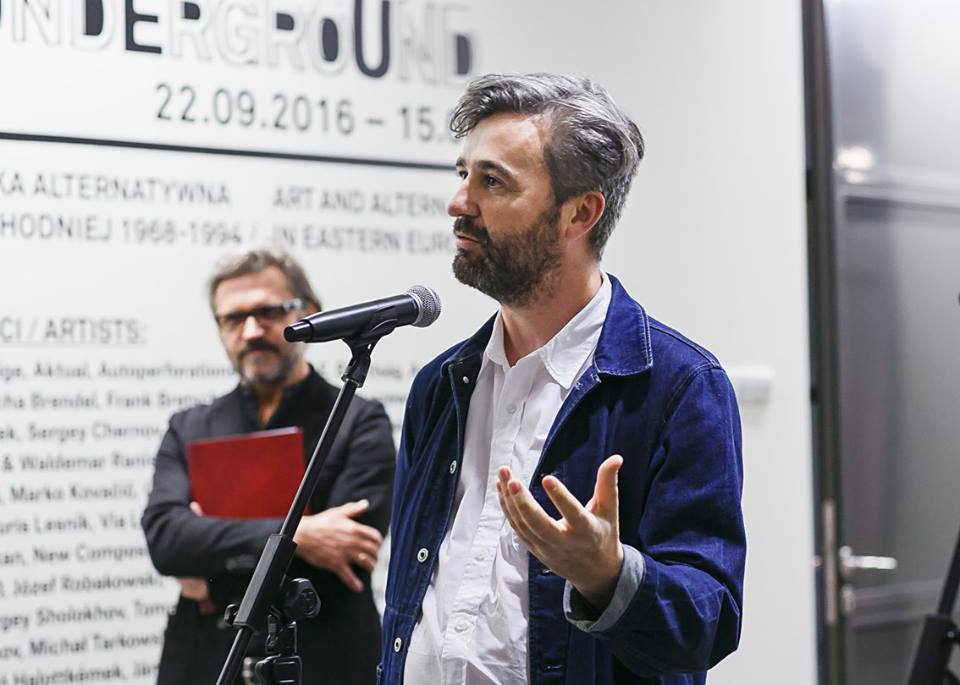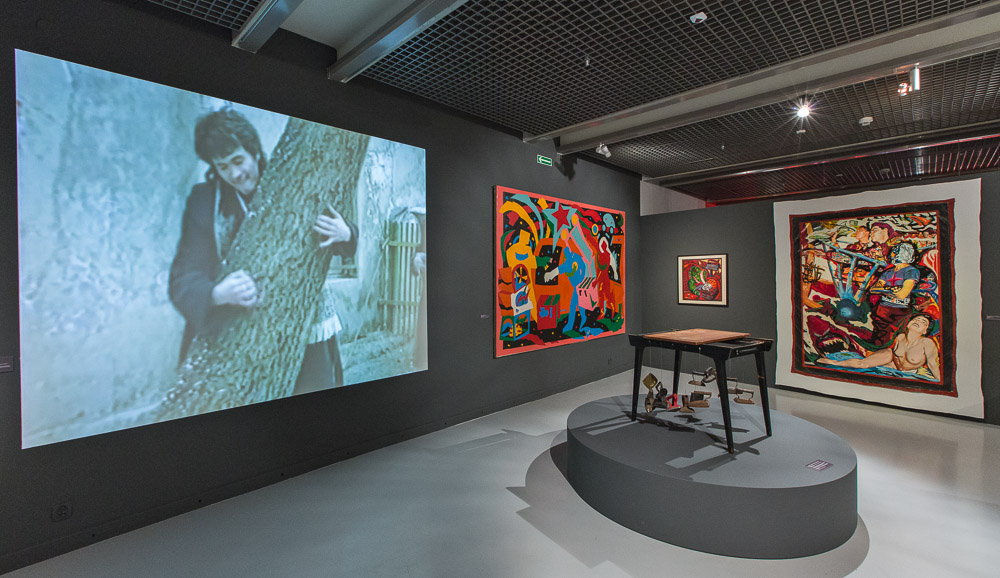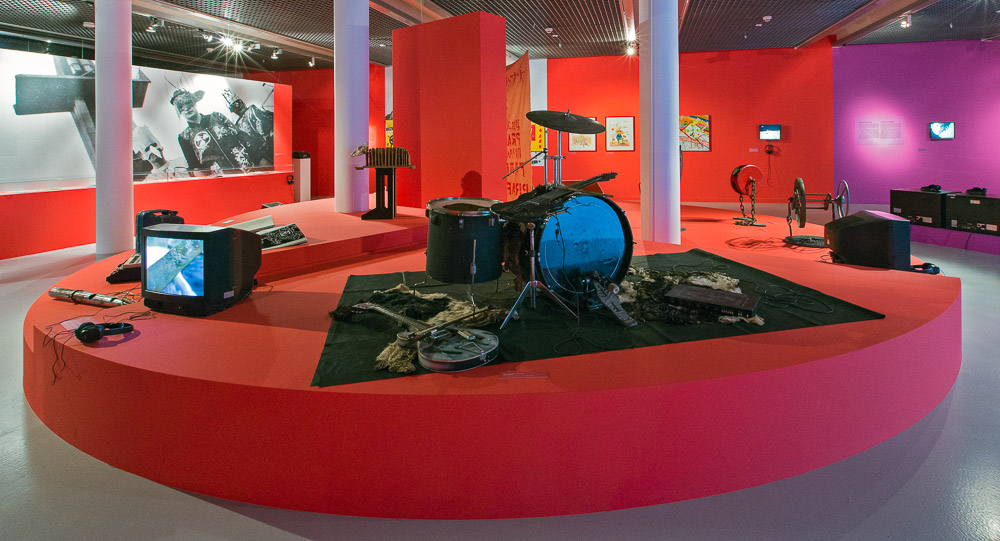
‘Notes from the Underground’, photo J. Kostarska -Talaga, courtesy of Muzeum Sztuki, Łódź, 2016
Anna Prokop:The exhibition ‘Notes from the Underground: Art and Alternative Music in Eastern Europe 1968-1994’ concerns a huge phenomenon. The time frame and the subject areas are specified, but the term ‘underground’ appears to be quite complex — what hides behind it? How do you understand it?
David Crowley: I think, in a simple sense, the underground is a very kind of attractive myth. To be in the underground carries all of those associations with being outside the official sphere. But I think what’s interesting about the term, at least for us, is that it opens up a more complex argument in a setting of the 1970s and 1980s in Eastern Europe. Many of the artists and musicians that we focus on in the Łódź exhibition were not only outside the official sphere, but they were also outside of what we might describe as dissenting culture, in a kind of third zone, one which was between those two worlds.
Daniel Muzyczuk: The title of this exhibition, ‘Notes from the Underground’ clearly refers to Fyodor Dostoyevsky’s novel but it also invokes the term used in the Europe and the US to describe a parallel culture, i.e. the culture which was an alternative to ministerial culture (as some of the underground activists used to call the officially approved culture), or to the state-promoted culture of the Eastern Bloc. I call this a parallel culture because the underground needs the mainstream in order to demonstrate its independence. Underground artists also emphasised those distribution channels which significantly differed from the channels employed by mainstream artists. The Aktual group founded by Milan Knižak, and The Plastic People of the Universe used the words ‘Assault on culture’ [Atentát na kulturu], a Czech expression in the 70s when the dissidents were being imprisoned. Underground is a specific strategy of creating culture by means of placing oneself outside of it. It is very often about being in clear opposition to mainstream culture. Despite that, such attitude did not prevent underground artists from seeking loopholes in the system and inventing ways to obtain state funding to achieve their own goals. Alternative activists painstakingly watched out for signs of the system becoming less hermetic, moments when they could break in and occupy a space on the margins, and then use every opportunity which the system offered.

Display view, ‘Notes from the Underground’, photo P.Tomczyk, courtesy of Muzeum Sztuki, Łódź, 2016
AP: Aktual group, spearheaded by Milan Knizak, used to parody the official language of the party; Borghesia – political and sexual taboos; New Composers — media manipulations; Sergey Kuryokhin even prepared a fictional documentary “Lenin was a Mushroom” (which is brilliant) …To what extent is [the underground] in Eastern Europe politically engaged? Was the term ‘underground’ inseparably connected with politics?
DC: I think you can definitely see politics at work in lots of the artworks and performances that interest us. But whether we should use the phrase ‘politically engaged’ is less certain. It suggests kind of ideological opposition. Many of the artists and musicians in the show belong to a generation living in Eastern Europe for whom politics was, of course, inescapable, but the nature of the engagement they made with it was often ironic or absurd. For instance, the final part of the show features various commentaries on the imagery of the Soviet avant-garde from 1920 and 1930s. We exhibit a ‘red-star dress’ made in 1987 on the sixtieth anniversary of the October Revolution by Tamás Király, an Hungarian fashion designer. That object is undeniably political: it’s a kind of ironic reworking of the symbols of Soviet socialism, but it was so absurd that I don’t think it can seen as an expression of politically engagement in that sense. Perhaps it testifies to a politics of absurdity.
DM: Our understanding of political engagement today is quite different from how this notion was understood in the 1960s or 1970s. The creation of alternative spaces was not considered political activity then. For a long time we have been aware that, in fact, what was private was political as well. For the members of The Plastic People of the Universe, Brygada Kryzys or Piotr Rypson, politics meant taking the same stand as political dissidents. The dissidents in Poland were mainly identified with KOR (Workers’ Defense Committee) and with Solidarity, i.e. the most prominent organisations fighting to introduce a democratic political system. In Czechoslovakia, opposition politics was focused by Charter 77 – an independent initiative promoting human rights. We can say that in some way the members of the underground were forced to form some kind of alliance with the Charter 77 dissidents. No such alliance was ever established in Poland. Dissident movement in the USSR was a marginal phenomenon, etc. Transnational movements, for example those related to neo-primitivism may seem culturally political to us, but their founders did not intend to establish any strongly politically-oriented initiatives. This is an extremely complex setting and mines can be found at every step of our way.

Display view, ‘Notes from the Underground’, photo P.Tomczyk, courtesy of Muzeum Sztuki, Łódź, 2016
AP: In the booklet you wrote about the difference between the underground in Eastern and Western Europe. In the West it manifested in everyday life (in the form of the ‘commune’), while in the East marginal areas were taken over to create and distribute the culture eluding censorship and control — was it an attempt to live in spite of everything, an attempt to create an alternative life, or an attempt to cross the border between life and art (following the Aktual or OHO groups’ aspirations)?
DC: It’s different in different places, right? And also in different times too. There were, in fact, various attempts to set up communes in Eastern Europe. There were hippie communes set up on the edges of Warsaw in the late 1960s, for instance. The generation which came of age in the late 1960s sometimes expressed radical ideas about society, often seeing the communist state, despite its rhetoric of revolution, as being fundamentally conservative. I guess the closest we get to this in the Łódź show is with the OHO Group in Slovenia. Active artists and film makers in the 1960s, then in the early 70s formed a commune calling themselves the ‘Šempas Family’, departing the city to live in the countryside. But alterity is not necessarily a fixed or unchanging state. So, for instance, we feature art and documentary material from Leningrad from the 1980s. There, artists and musicians associated with the New Artists – a large and shifting alliance – began by occupying marginal spaces like apartments and churches in the ‘classic’ manner of non-conformist art. They then moved into occupying official spaces such as student clubs, turning them into their own zones for culture creation. When Perestroika and glasnost were announced along in 1985-6, the New Artists were in a good position to become minor celebrities of the reform movement which had been licensed across the country by Gorbachev. The cult film, Assa which records the lifestyle of the new wave artist and musicians, is a kind of spectacularisation of a marginal subculture.
AP: The situation in every country in Eastern Europe was ‘slightly’ different, but at the same time they shared a kind of common experience. You’ve underlined the categories of „improvisation” and „primitivism” as the main examples — what were their roles and how did the artist use them? Were there any other points in common?
DC: I think, a simple way of making an exhibition like this would be to tell national stories in the form of micro histories. But what I think is more challenging, and more interesting, is to seek out those commonalities and differences across the so called Eastern Bloc and former Yugoslavia. One of the curatorial decisions that we’ve taken has been to do with the way that we have organized the show. In many ways, we’ve taken existing knowledge and materials which have been gathered by others in different national settings but we’ve tried to invent new categories with which to make sense of this phenomena. Let me give one example: when one looks across the Bloc in the 1980s, it’s really striking that suddenly young artists and musicians throughout Eastern Europe engaged in practices of what might be called ‘self-primitivisation’. Ziemia Mindel Würm in Gdansk in the second half of the 1980s presented themselves as kind of post-apocaliptic and abject people living in a broken world. You can find the same thing in Leningrad and in Tallinn too, despite the fact that these artists and musicians didn’t know each other. So the question is why? Why was this mood shared across the region? I think that for one thing, this generation shares a sense of living at the end of a social experiment, Soviet-style socialism. This was an ideology that said to its citizens ‘you are the people of the future’. Quite brilliantly, these artists and musicians chose to resist that rhetoric by presenting themselves as being like primitive people. We’ve identified about 3 or 4 transnational patterns like this for the show.
DM: Our exhibition also refers to a trend called “overidentification” discussed by Slavoj Žižek. Overidentification is a rather complex mechanism, but for the purpose of this conversation it can be understood using identification, as a tool, to such a degree that it becomes unreasonable. A good example was the activities of the Slovenian industrial music group, Laibach. They used symbols related to Nazi and Soviet ideology. Ultimately, their audiences were uncertain as to the group’s real beliefs and values. The Aktual group in Czechoslovakia also had a tendency to overidentify in songs like ‘The children of Bolshevism’ and ‘I love you and Lenin’. In the East, irony needed to be hidden deeply for the censor not to be able to justify why, in his opinion, these ironic statements had counterrevolutionary character or why they were an ‘attack on culture’. The censor was looking for a reason to forbid public presentation of the works. Such strategies were not developed in the West, since censorship there was never as strict as in the countries of the Eastern Bloc. It is also interesting to see that these strategies had potential and were efficient in a given moment and are now useless for critical engagement into the paradoxes of neoliberalism. That also proves that they were one of the unique traits in the region during socialism.

Display view, ‘Notes from the Underground’, photo P.Tomczyk, courtesy of Muzeum Sztuki, Łódź, 2016
AP: Social communication was undoubtedly obstructed, so the another channel of communication had to be created, and it was connected with DIY or amateur culture. New private labels were created (like label Seque established by Ledniš from NSRD), in Poland we had „Post” zin (edited by Henryk Gajewski and Piotr Rypson), samizdat was one of the tools/ways by which the artist tried to avoid the system — what were the other mechanisms/tools they used?
DC: We know a lot about samizdat publishing; it has been well studied. And we know about punk in Eastern Europe too, particularly in places like Yugoslavia. If we put the samizdat and punk DIY approaches together, new connections form. For instance, Artpool in Budapest built a kind of alternative system for the production and the exchange of knowledge. This was a samizdat-sensibility which had its roots in mail art, but their publications and cassette tapes drew on new punk aesthetics too.
This was also a form of improvisation with demotic media like photocopiers, a controlled technology in Eastern Europe, and tape-recorders. In the exhibition, we make a feature of this kind of improvisation because it seems to be a parallel track to the better-known understanding of improvision in music, largely in jazz and rock. It also might be understood as a kind of embryonic form of ‘hacking’. We talk a lot about hacking today in our post-digital era. Perhaps our forebears are those artists and musicians in Eastern Europe in the 1980s who, facing difficulties obtaining equipment, became adept at hacking. Hacking wasn’t just a matter of utility and need: it was also a kind of creative imagination too. Artist Wojciech Bruszewski who made his own kind of electronic instruments in an ad hoc manner, was a brilliant hacker in this sense: his hacked record player and televisions were diagnoses of the monopoly of the media operated by the state in Poland in the 1970s and 1980s
AP: Music, which has been built around subcultures, such as punk or industrial, constitute as powerful tools of expression. However they can sometimes vary a bit depending on the environment (country) and their specific ‘local’ features. How did the East European strand of punk and industrial looked like?
DC: I’m quite cautious about the question… When they visit this exhibition, I think that a lot of people will expect to see a kind of East-West comparison – eastern copies of western originals. This would be to repeat one of the dominant narratives about any Eastern European culture after 1945, namely that it is somehow a copy of what happened in the West, and always a delayed one at that. And of course that’s sometimes true … But I don’t find this model of thinking very interesting. It always renders the Eastern European experience as an imitation of some kind of authentic thing. Isn’t it more interesting to ask ‘Why was punk needed in Eastern Europe at the moment when it appeared?’ Perhaps we also have to give more credit to the fantastic power of the imagination too — many of those Eastern Europe subcultures didn’t have an easy access to Western records and images, so often they projected an imaginary West. This is not our argument but Alexei Yurchak’s in his book ‘Everything was forever, until it was no more’. And perhaps more interestingly, subcultural groups in Leningrad, Budapest or Wroclaw not only fantasised about the West, but about the East too. The images of the Soviet avant-garde in 1920s came into vogue in the 1980s. The New Artists in Leningrad, operating in 1983-85, were living through a rather stagnant period of Soviet history under Brezhnev. And perhaps for this reason they made a connection – in their words, sounds, images and above all in their style, to the Russian futurists in the 1910s. In this way, they reimagined themselves.
DM: We all know the circumstances in which punk music was born in the UK – strikes and social crisis gave birth to a new young generation which formed its identity through protest. But at some kind of basic level, movements such as punk are undoubtedly transnational. It is the different types of threats to which they were subject that is the main recognisable difference. The type of confrontation certainly depends on the parties which stand against each other. In the 80s, East Germany fought against the punk underground in an aggressive way, namely by resorting to physical violence and arresting them.
There are several types of communication and relationships between the system and the underground. It would be difficult to create a single coherent picture and, at the same time, not to excessively generalise. The movements I mentioned had different form and structure, and served various needs, depending on the time and place in which they developed and operated.
AP: One of the axes (dimensions/aspects) of this exhibition is the juxtaposition/combination of the aural/sonic and the visual. The period of time that you’ve focused on (let’s say second half of XXth century) was also the time when the term ‘sound art’ appeared — do you think that this concept is somehow connected with the art works that you present? I am asking this question, because I found this term only once in the booklet.
DC: I’m not very keen on the category of sound art for the reasons that many others have expressed – that it defines itself in rather narrow mediumistic terms. It was not a category which operated in the setting which we’ve set out to explore either, that is Eastern Europe under communist rule after 1968. Understand these various practices from the perspectives of the people who made these objects is a challenge but worth doing. For groups like Ornament & Verbrechen in East Germany or A.E. Bizottság in Hungary, the distinction between vision and the sound was irrelevant: what mattered was their capacity to be brought together. They didn’t talk about sound art as a kind of category, this was not a part of their vocabulary. ‘Punk’ and ‘jazz’ or even ‘jazz-punk’ describe their output much more effectively even if they lack precision.
DM: It seems to me that this notion is not useful for us because it is related to a specific kind of art, its certain genre, which is really rare in case of works we present, and phenomena we are interested in. For me, sound art is a kind of art which expresses an unusual surprise at sound reproduction, concentrating on its spatial dimension, transmission, etc. I prefer the notion of ‘audiovisual arts’. While preparing ‘Notes from the Underground’ we concentrated on movies, video, LPs, their special packaging and the intermedia culture from which they emerged – all of which ignores the division between different genres. Sound art is a specific kind of art whereas we, in contrast, were interested in bigger issues. When I prepare exhibitions, I try to select objects, works and artefacts which are not just what they are and exist for the very sake of it, but which can help me create a concise story. When we prepared an earlier exhibition, entitled ‘Sounding the Body Electric’ focusing on experimental art and music in Eastern Europe in the 1960s, we had some challenging moments while dealing with things that did not have their own names yet. At such moments, just as Zygmunt Krauze and Teresa Kelm who used a notion developed by Katarzyna Kobro (i.e. spatial-musical composition, which is a clear reference to Kobro’s spatial composition), we tried to present many different ways of describing works and phenomena. Despite popular belief, such a quest does not equal being lost, but it is rather a natural reaction at the time when our culture, which is based on disciplinary visions, cannot deal with the unexpected variety intermedia culture.
Notes from the Underground. Art and Alternative Music in Eastern Europe 1968-1994 is on show until 15 January 2017 at the ms² -Muzeum Sztuki in Łódź, ul. Ogrodowa 19

Display view, ‘Notes from the Underground’, photo P.Tomczyk, courtesy of Muzeum Sztuki, Łódź, 2016

Daniel Muzyczuk, curator of the exhibition ‘Notes from the Underground’, photo A. Tarska – Pietrzak, courtesy of Muzeum Sztuki, Łódź, 2016

David Crowley, curator of the exhibition ‘Notes from the Underground’, photo A. Tarska – Pietrzak, courtesy of Muzeum Sztuki, Łódź, 2016

Display view, ‘Notes from the Underground’, photo P.Tomczyk, courtesy of Muzeum Sztuki, Łódź, 2016

‘Notes from the Underground’, photo J. Kostarska -Talaga courtesy of Muzeum Sztuki, Łódź, 2016

Display view, ‘Notes from the Underground’, photo P.Tomczyk, courtesy of Muzeum Sztuki, Łódź, 2016







